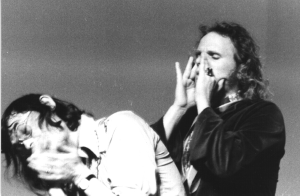Sound Poetry
 Steve McCaffery and bp
Nichol,
Steve McCaffery and bp
Nichol,
First West Coast International Sound Poetry Festival, San Francisco,
1977
Sound poetry has probably always been with us in one form or
another: as oral tradition in preliterate and
non-western cultures, words of power like the Tetragrammaton and the Logos,
glossolalia of fanatics and schizophrenics, the baby talk that is lost through
the phonetic limits of learned language skills, voices used for advertisements
and cartoons, to cite a few of the more obvious examples. In sound poetry the
conventional hierarchy between sound sense and semantic sense is modulated and
often reversed. The semantic sense does not necessarily have to be completely
neglected but it assumes a more democratic role with the addition of any
element that can be vocalized. Sten Hanson has described sound poetry as a
combination of the exactness of literature and the time manipulation of
music.
As the result of a direction inward since the 16th century
with the decline of manuscript
culture and the rise of personal literacy, a study of language was the way
to know God, his universe, the societies of man, and then the human soul
itself. In the 19th century, a romantic view that the universe was a language
became popular. Everything represented a collection of signs and symbols, which
man could eventually interpret and understand if they worked hard enough at it.
In the 20th century, a rebellion against the tyranny of print culture and its reduction of all expression
to that which can be notated, occurred. Sound poetry is part of that rebellion.
This is not to say that sound poetry, exists without visual notation (see
concrete poetry), but if such a graphic
cueing system does exist, it is often highly individualistic, and can stand by
itself as a visual object. For sound poets, like most other post cognitive
artists of the 20th century, the work becomes the thing in itself, not an
interpretation to be abstracted into something else.
Work in this century which has been
identified with sound poetry, has its beginnings in the onomatopoetic parole
in liberta of the Italian Futurists. Though
not strictly sound poetry, much of their activities presaged the development of
the phonetic poem, and the activities of Russian
Futurism and Dada. Language was not truly
atomized however, until the introduction of electro-acoustic methods. This development provided both
the means and a new way to hear the voice which could then be mimicked by
non-electronic means.

Last Modified 21 January 1998
 Steve McCaffery and bp
Nichol,
Steve McCaffery and bp
Nichol,